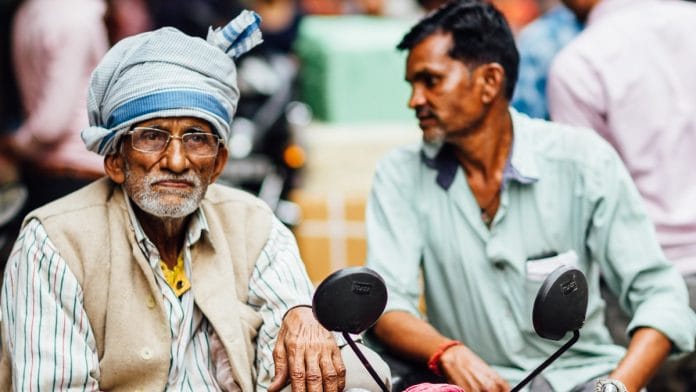New Delhi: India’s elderly population (aged 60 and above) is projected to touch 194 million in 2031 from 138 million in 2021, a 41 per cent increase over a decade, according to the National Statistical Office (NSO)’s Elderly in India 2021 report.
Flagging concerns around an ageing population and stressing the need for India to plan for a changing population structure, the report said there will be 93 million males and 101 million females in 2031 — up from 67 million males and 71 million females in 2021.
The report published Thursday cited findings from the Technical Group on Population Projections for India and States 2011-2036 for its predictions.
The NSO, which falls under the Ministry of Statistics and Programme Implementation (MoSPI), sought to provide insights about the problems and status of elderly persons in the country, and help in policymaking.
The report stressed the 2017 United Nations Report on World Population Ageing, which claimed that by 2030 the people aged 60 years or above are expected to outnumber children under age 10.
Also read: How UP could achieve ‘population stabilisation’ by 2026-30 even without a law
Share of population
The report said there is likely to be an increase of nearly 34 million elderly persons in 2021 as compared to 2011 (104 million). This is projected to rise by around 56 million over the next decade.
The percentage share of the elderly population in the total population is said to rise from 8.6 per cent in 2011 to 10.1 per cent in 2021 and projected to touch 13.1 per cent in 2031.
Census 1991 showed the elderly female population (29.4 million) outnumbered elderly males (27.3 million). The NSO report said this trend has strengthened in the last two decades. The elderly female and male population is now projected to rise to 100.9 million and 92.9 million, respectively, in 2031.
The elderly population’s decadal growth (population growth rate over a 10-year period) compared to that of the general population showed a huge contrast.
While elderly decadal growth is predicted to rise from 35.5 per cent in 2001-11 to 35.8 per cent in 2011-21 to 40.5 in 2021-31, the growth is said to decline from 17.7 to 12.4 to 8.4 per cent in the general population, respectively.
The average annual growth rate of the elderly population as compared to the Population Census 2011 is 3.28 per cent.
State-wise data
According to the report, Kerala currently has the highest elderly population (16.5 per cent), followed by Tamil Nadu (13.6 per cent), Himachal Pradesh (13.1 per cent), Punjab (12.6 per cent) and Andhra Pradesh (12.4 per cent) in 2021.
Bihar, Uttar Pradesh and Assam have the least proportion with 7.7 per cent, 8.1 per cent and 8.2 per cent, respectively.
A decade from now, the same five states are projected to have the maximum proportion of elderly people in its population — Kerala (20.9 per cent) followed by Tamil Nadu (18.2 per cent), Himachal Pradesh (17.1 per cent), Andhra Pradesh (16.4 per cent) and Punjab (16.2 per cent).
Over the last decade, the highest average rise was observed in Delhi (6.60 per cent), Gujarat (4.88 per cent) and West Bengal (4.27 per cent). The least average increase has been seen in Uttar Pradesh (2.16 per cent) followed by Bihar (2.28 per cent) and Madhya Pradesh (2.53 per cent).
Also read: Population control is already on. Adityanath’s bill risks reversing UP’s improving trends
Economic status of elderly population
The report noted a significant increase in the old-age dependency ratio, which rose from 10.9 per cent in 1961 to 14.2 per cent in 2011 and is projected to increase to 15.7 per cent and 20.1 per cent in 2021 and 2031, respectively.
The dependency ratio for female and male is expected to reach 14.8 per cent and 16.7 per cent, respectively, in 2021.
The old-age dependency ratio is defined as the number of persons aged 60+ per 100 persons relative to the age group 15-59.
Census 2011 showed the overall old-age dependency ratio varied from 10.4 per cent in Delhi to 19.6 per cent in Kerala. This is further projected to vary from 12.7 per cent in Assam to 26.1 per cent in Kerala in 2021.
For 2031, the old-age dependency ratio could vary from 15.6 per cent in Bihar to 34.3 per cent in Kerala.
The report noted that the female old-age dependency ratio as compared to male is significantly high in states like Kerala, Tamil Nadu, Himachal Pradesh and Punjab in 2021.
Other indicators
The report said literacy levels among elderly males and females have improved over time in both rural and urban areas, but it noted a huge gender gap, with only 28 per cent female elderly literate as against 59 per cent males (Population Census 2011).
The difference is even starker in rural areas where 51 per cent males were literate against 18 per cent of women.
The average number of years in formal education among persons aged 60+ is the highest in Chandigarh (12.7 years) followed by Delhi (10.7 years) and is the lowest in Sikkim (6.2 years), followed by Mizoram (6.3 years) and Daman & Diu (6.5 years).
Also read: Lok Sabha strength to be increased to 1,000 from 543? Here’s how it can be done






